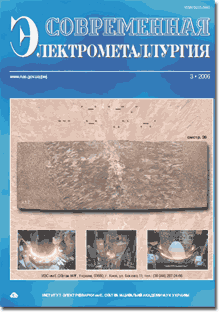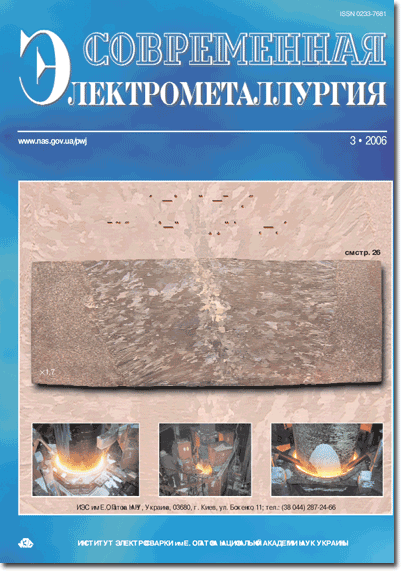| 2006 №02 | 2006 №04 |

CONTENTS

ELECTROSLAG TECHNOLOGY
Eryomin E.N. Application of modifying for improving properties of annular billets from nitrogen-containing stainless steels produced by method of centrifugal electroslag casting 2
New technology for centrifugal electroslag casting of annular billets from high-strength stainless steels, including modifying of the molten metal by dispersed particles of molybdenum and vanadium, is described. Results of the cast metal tests and advantages of modified cast billets are presented.
Lakomsky V.V., Pomarin Yu.M., Grigorenko G.M. and Orlovsky V.Yu. On transportation of nitrogen through molten slag 7
Feasibility of nitrogen transportation through the molten oxide and fluoride-oxide slags is considered on the basis of analysis of literature sources. Assumption is made that nitrogen permeability can be defined not by solubility of nitrogen in slag, but, probably, by the value of chemical potential of gas in the slag and the metal.
ELECTRON BEAM PROCESSES
Trigub N.P., Zhuk G.V., Chepinsky A.A., Tarasov K.K., Kurilenko P.V., Antipieva N.V. and Kopylova N.E. Investigation of process of manufacturing hot-rolled and cold-formed pipes from cast non-deformed pipe billet of titanium alloy VT1-0 produced by method of electron beam melting 10
Technology of manufacturing hot-rolled and cold-formed pipes directly from ingots of electron beam cold hearth melting has been developed. Quality of pipes of intermediate and finished sizes was investigated. It is shown that mechanical properties of pipes are in compliance with requirements of State standards.
Stelmakh Ya.A., Melnichenko T.V. and Movchan B.A. Structure and properties of thick MgO condensates produced by electron beam evaporation 13
Effect of substrate temperature on structure, morphology of surface, microhardness, and fracture toughness K1c of MgO condensates of up to 100 mm thickness, produced by electron beam evaporation and deposition in vacuum on substrates of steel St3 within temperature range 300–1000 °C, is investigated. Temperature relationship of width of MgO columnar crystallites is presented. It is shown that microhardness of MgO is constant within preset range of temperatures and does not change at high-temperature annealing. It is established that temperature of condensation predetermines nature of the relief formation and texture of condensates.
PLASMA-ARC TECHNOLOGY
Grigorenko G.M., Pomarin Yu.M., Orlovsky V.Yu. and Lakomsky V.V. Kinetics of nitrogen absorption by molten highly reactive metals in arc and plasma melting 18
Kinetics of nitrogen absorption by molten vanadium, zirconium and niobium, using methods of arc and plasma melting of metal within temperature interval 2273–2873 K and nitrogen partial pressure range 0.09–25 kPa has been investigated. Methodology of direct measuring metal temperature in melting using color pyrometers has been developed. It is shown that as temperature grows, rate of nitrogen absorption increases, while threshold concentration does not change in comparison with nitrogen absorption in conventional oscillation state (levitation melting). Rate of nitrogen absorption in plasma melting is higher than in arc melting that is connected with higher energy activation of nitrogen molecules in gas phase.
Kostyakov V.N., Poletaev E.B., Grigorenko G.M., Medved S.N. and Shevchuk E.A. Behavior of phosphorus in liquid-phase reduction melting 21
Behavior of phosphorus in liquid-phase melting of dump electric steel melting slag has been studied. It is shown that combination of oxidizing and reduction periods in liquid-phase melting does not allow performing dephosphorization of the metal.
VACUUM-INDUCTION MELTING
Chervony I.F., Shvets E.Ya. and Egorov S.G. Melting of silicon in vertical induction crucible-free zonal melting 24
Conditions of melting initial crystal of silicon in vertical induction crucible-free zonal melting are considered. It was established that for ensuring flowing off of the molten metal it is necessary to significantly increase radius of a drop contact area at minimum thickness of the melt layer on the surface of melting. Optimum conditions of melting are defined for effective flowing off of the molten metal, formed on a part of the initial crystal surface, into general zone.
GENERAL PROBLEMS OF METALLURGY
Kurenkova V.V., Malashenko I.S., Trokhimchenko V.V., Chervyakova L.V. and Rabinovich A.A. Short-term strength of brazed joints of nickel alloy VJL12U at temperatures 20 and 950 °C 27
Effect of chemical composition of composite brazing filler alloys, used in high-temperature resistance brazing, on strength of brazed joints of casting alloy VJL12U at temperatures 20 and 950 °C has been considered. Application of isothermal brazing with low-melting brazing alloy Ni–Co–Cr–Al–2.5 % B in mixture with a filler from powders of alloys Rene-142 and JS6U (up to 50 wt.%) within temperature range 1215–1220 °C (15–10 min) made it possible to produce brazed joints of strength, constituting 90–95 % of the base metal strength at room temperature and 70–85 % at 950 °C. Microstructural peculiarities of brazed joints after different kinds of heat treatment are considered.
Khizhnyak V.G., Pomarin Yu.M. and Tereshchenko P.A. Diffusion titanizing of tungsten-free hard alloys TN20 and KKhN15 38
Effect of technological parameters of diffusion metallization by titanium in close reaction space in chlorine on phase composition, structure and certain properties of coatings on tungsten-free hard alloys TN20 and KKhN15 was studied. Nickel participation as the basis in formation of diffusion zone of layers of intermetallics TiNi3 and TiNi is shown. It was established that microhardness of TiC layers on investigated alloys is 19&ndash24 GPa, Ni3Ti Е 6 –12.5 GPa, dependence of thickness of carbide and intermetallic layers on temperature and time of saturation is of complex nature.
ELECTROMETALLURGY OF STEEL AND FERROALLOYS
Novikov N.V., Kapran I.I., Sokolov K.D., Gasik M.I. and Ovcharuk A.N. Innovation technological processes of electric furnace ferronickel refining by progressive industrial methods. Part 3. Processes and technology for refining ferronickel in acid and basic oxygen converters 41
Results of thermodynamic investigation of reactions of oxidizing of dissolved in ferronickel silicon and chromium by oxygen in the converter with silica brick lining, as well as carbon, phosphorus and sulfur in the converter with periclase-carbon lining are described. Technological conditions of ferronickel blowing by oxygen using single-nozzle lances, chemical compositions of slag phases, and behavior of impurity elements are shown. Processes of deoxidizing after oxygen refining of ferronickel by silicon and aluminum and principles of mechanized casting technology are considered.
Saviuk A.N., Derevyanchenko I.V., Kucherenko O.L., Projdak Yu.S., Stovpchenko A.P., Kamkina L.V. and Grishchenko Yu.N. Peculiarities of producing intermediate product for manufacturing especially low-carbon steel in electric arc furnace 45
Specifics of steel production under conditions of Moldavian Metallurgical Works are considered. Feasibility of producing ultra-low amounts of carbon using arc steel-melting furnace–evacuator–ladle-furnace scheme is shown.
ENERGY AND RESOURCE SAVING
Kostyakov V.N., Grigorenko G.M., Poletaev E.B., Medved S.N. and Shevchuk E.A. Power consumption of liquid-phase reduction melting process 50
Calculation was used to estimate power consumption in liquid-phase melting of metal oxides. It is shown that in steel melting power consumption depends upon type of metal oxides and their content in the charge.
INFORNATION
Thesis for a scientific degree 52
Developed at PWI 17, 26, 40, 49
(You are viewing the simplified file contents)
The cost of subscription/purchase order journals or individual articles
| Journal/Currency | Annual Set | 1 issue printed |
1 issue |
one article |
| TPWJ/USD | 384 $ | 32 $ | 26 $ | 13 $ |
| TPWJ/EUR | 348 € | 29 € | 24 € | 12 € |
| TPWJ/UAH | 7200 UAH | 600 UAH | 600 UAH | 280 UAH |
| AS/UAH | 1800 UAH | 300 UAH | 300 UAH | 150 UAH |
| AS/USD | 192 $ | 32 $ | 26 $ | 13 $ |
| AS/EUR | 180 € | 30 € | 25 € | 12 € |
| SEM/UAH | 1200 UAH | 300 UAH | 300 UAH | 150 UAH |
| SEM/USD | 128 $ | 32 $ | 26 $ | 13 $ |
| SEM/EUR | 120 € | 30 € | 25 € | 12 € |
| TDNK/UAH | 1200 UAH | 300 UAH | 300 UAH | 150 UAH |
| TDNK/USD | 128 $ | 32 $ | 26 $ | 13 $ |
| TDNK/EUR | 120 € | 30 € | 25 € | 15 € |
AS = «Automatic Welding» - 6 issues per year;
TPWJ = «PATON WELDING JOURNAL» - 12 issues per year;
SEM = «Electrometallurgy Today» - 4 issues per year;
TDNK = «Technical Diagnostics and Non-Destructive Testing» - 4 issues per year.





